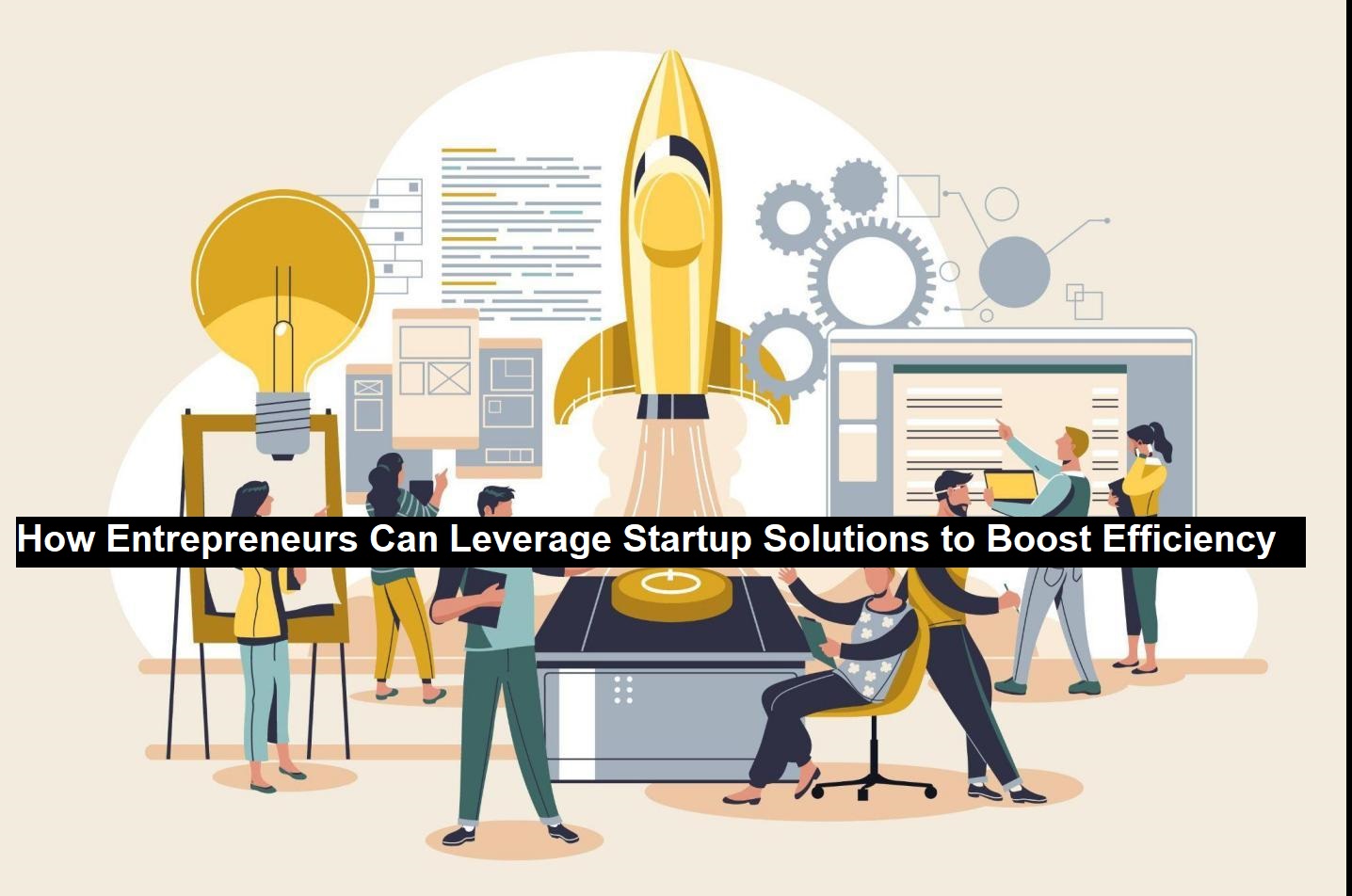In the dynamics of startups and entrepreneurial activities, productivity is highly valued. There is definitely pressure on entrepreneurs to cut costs, get rid of any lack of focus and neglecting expenses and inefficiencies. Thanks to the wide range of startup solutions ranging from software to automation solutions business owners can enhance the effectiveness. This article examines how sustainable improvement initiatives can be chosen, the most suitable startup solutions can be selected, and how these can be put in practice properly; lastly, it also discusses the methods of evaluating the success of these improvements.
Identifying Key Areas for Efficiency Gains
- Understanding Your Current Processes
However, to manage and innovate such solutions, it is crucial to conduct an evaluation of existing flows first. When you take stock of your activities, it will be possible to identify constrains, activities that take abnormally long time and activities that are vulnerable to human interference. That’s exactly that being able to identify where are the inefficiencies, means that one can target where one can get the most value add.
- Common Areas for Improvement
Some common areas where startups often find opportunities for efficiency gains include:
- Communication and Collaboration: Lack of interaction and integration between various functional teams is one of the causes of delays.
- Customer Relationship Management (CRM): Dealing with customer relations and information might be a real problem without proper software tools.
- Financial Tracking and Reporting: Financial management in startups is nonexistent in most cases, costing the businesses market possibilities and unrecorded spending.
- Task Management and Workflow Automation: This reveals that manual procedures form a key bottleneck and that automation is an important avenue for improvement.
Read: Beyond Attendance Figures: A Deep Dive into Event Metrics
Popular Startup Solutions for Efficiency
1. Communication and Collaboration Tools
Startups often benefit from tools that facilitate seamless communication across teams and locations. Some popular options include:
- Slack: A messaging platform that enhances team collaboration with organized channels and integrations.
- Microsoft Teams: An all-in-one platform for meetings, messaging, and file-sharing.
- Asana and Trello: Task management tools that keep everyone on the same page and reduce miscommunications.
2. Customer Relationship Management (CRM) Software
CRM systems are essential for managing customer data, tracking sales, and personalizing interactions. Some of the top CRM solutions for startups include:
- HubSpot CRM: It is easy to use for every organization and also good for the marketing automation of organizations.
- Salesforce Essentials: Intended for small businesses with an opportunity for CRM services’ expansion to large companies when necessity arises.
- Zoho CRM: Integrates several appealing characteristics with cost efficiency, which is a notable advantage for startups.
3. Financial Management Tools
Tracking finances is crucial for startups to maintain budget control and improve financial decision-making. Top tools include:
- QuickBooks: Automated procedure to record expenses and kimoun financial expenses, For example, automatically reduces excessive bookkeeping complexity.
- FreshBooks: Quite simply, it is an easy-to-use invoicing, time tracking and expense account system.
- Xero: Presents strong accounting functions in an interface that is intuitive best for growing startups.
4. Workflow Automation Platforms
Workflow automation reduces the time spent on repetitive tasks, allowing teams to focus on value-driven activities. Leading solutions include:
- Zapier: Connects apps and automates tasks across platforms without needing to code.
- Integromat (Make): Provides a visual approach to creating complex automation workflows.
- Monday.com: A versatile tool that combines task management with automation features.
5. Project Management Tools
Managing projects efficiently is critical for startups. Effective project management solutions ensure deadlines are met and resources are used effectively:
- Jira: A favorite among software development teams for its advanced project tracking.
- Basecamp: A simple, intuitive project management tool suitable for teams of all sizes.
- ClickUp: Offers a comprehensive project management solution that scales as businesses grow.
How to Choose the Right Solutions
- Define Your Goals and Budget
There is a need to understand which particular objectives you have for using these solutions. So whether you want to raise efficiency levels, enhance client interactions, or decrease organizational expenditure, these objectives will influence your decision. It is also important to know your budget at this stage because you should invest in a technology with the potential of generating returns without putting a great deal of pressure on the budget.
- Consider Scalability
Solution selection with scalability is ideal since you can adapt the solutions to future needs. Organization structures in startups tend to change quite fast, and selecting software that adapts to these changes minimizes instances where changes require new software to be brought in.
- Evaluate Usability and Integration
Ease of use is critical because more often than not complicated tools only increase the ineffectiveness in the process. Integration capability are just as important; this argues that various system should be able to interface thereby boasting of a unified approach in the enhancement of efficiency.
- Seek Recommendations and Trial Periods
Use online consumer review, consult with other businessmen and use free trial period for specific applications. A trial edition also give the user the chance to consider whether or not the tool is appropriate for the particular startup that they are running, without having to spend any money.
Implementing Startup Solutions Effectively
- Plan the Rollout
After deciding on the right solution, planning is crucial. Introducing an implementing a tool at a time is helpful because it allows the teams to learn how to use the tool without getting overwhelmed.
- Train Your Team
Make sure that those involved know how best to use the tools that you intend to introduce. Taking time and resources to train the employees helps to reduce on mistakes and gain perfect output within the shortest time.
- Monitor Adoption and Feedback
Find out the degree of compliance with new solutions by employees and also initiate the search for their opinions. It is advisable to tackle everything that might ensue later on when trying to optimize their efficiency as barriers that might prevent improvement.
Measuring Success and Adjusting Strategies
- Key Performance Indicators (KPIs)
Measuring the success of implemented solutions requires well-defined KPIs. For efficiency gains, relevant KPIs might include:
- Time Saved: Monitor how much time is saved by reducing manual processes.
- Error Reduction: Track any decreases in errors or mistakes due to automation.
- Customer Satisfaction: Use customer feedback to gauge improvements in CRM solutions.
- Revenue Growth: Evaluate whether streamlined operations positively impact revenue
- Continuous Improvement
Improvement is one thing that is not accomplished at once but is an ongoing process to make an organization efficient. You should always assess the effectiveness of the tools and strategies you use regularly, so that you stay informed and become as competitive as you can.
Challenges and Considerations
- Balancing Cost and Value
New solutions may be expensive for startups, so it is important to consider costs against the possible benefits in the process. There are usually open-source versions out there which one can use as spring boards before considering to put their money in the paid ones.
- Avoiding Over-Reliance on Technology
There is merit in germinating startup solutions that can increase business efficiency is a downside if answers are restricted to tools that get worn out or lack updates. Combining the appropriate use of technologies with a human component prevents the loss of efficiency improvements over the long run.
- Managing Change
New tools in the team’s work could have the positive but sometimes also negative impact in the beginning of their introduction into the team’s work. Organising change probably the most crucial steps in implementing change because where there is no organisational support, there will be organisational resistance.
Future Trends in Startup Solutions for Efficiency
- AI and Machine Learning
Artificial intelligence and machine learning have become transformative when it comes to productivity as they are providing real predictive capabilities for our industries and automating many of our increasingly complex tasks. Most CRM and workflow automation solutions are already adopting AI and this makes it easier for startups to predict their customer needs and grievances, respond to these proactively.
- No-Code and Low-Code Platforms
No-code and low code development app allows entrepreneurs to harness the ability to build customized applications without a high level of coding skills. This is one trend that has given the green light to startups to customize tools that meet their exact needs.
- Remote Work Solutions
With the advancement in technology and the ever increasing remote workforce, such solutions to support virtual teams are becoming mandatory. Teleconferencing, cloud computing and application sharing are quickly turning into organic models of communication given the geographical barriers.
- Sustainable Business Solutions
As startups foster their sustainable values, frugal tools that challenge paper consumption, energy intensity, or working from home become popular. Sustainable tools can add the effectivity of startups and make them more environmentally friendly.
Conclusion
Using startup solutions is crucial for any entrepreneur who would like to work efficiently and effectively in the modern business environment. By finding out the problem areas, selecting the right solution, deploying those solutions effectively, and evaluating the effectiveness, new age startups can witness phenomenal levels of efficiency improvement. That is, maintaining awareness of the future trends will help the entrepreneurs to expand the optimization of the operations in the course of technological changes.



